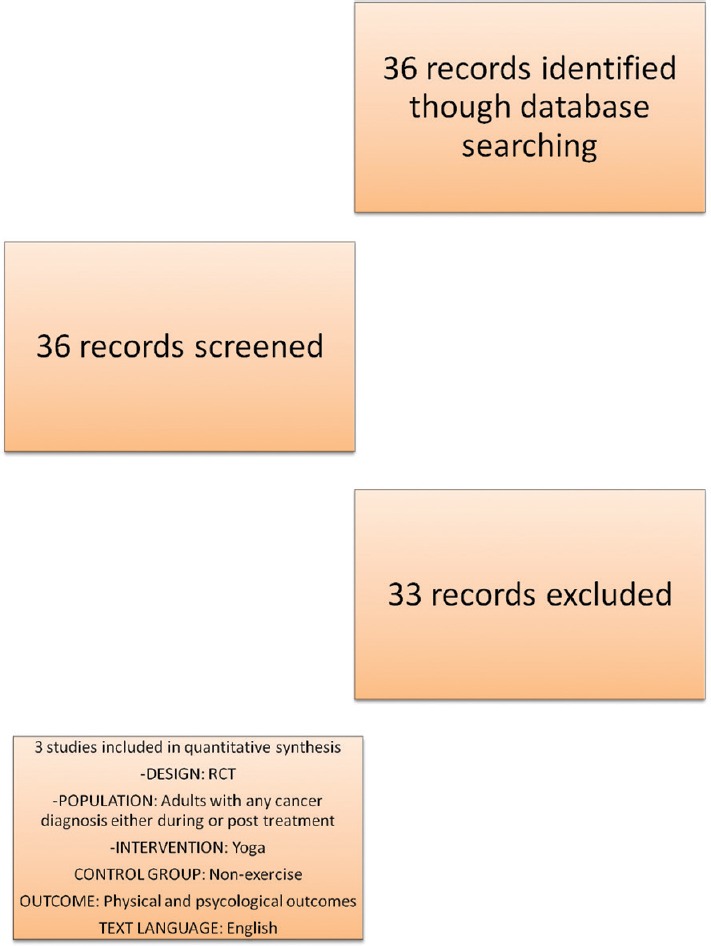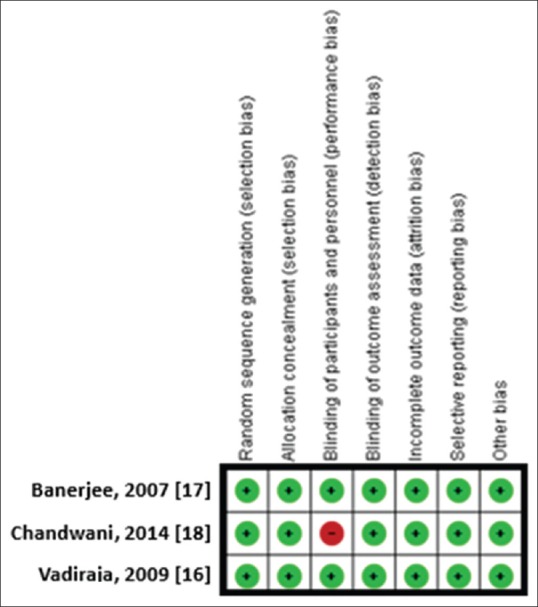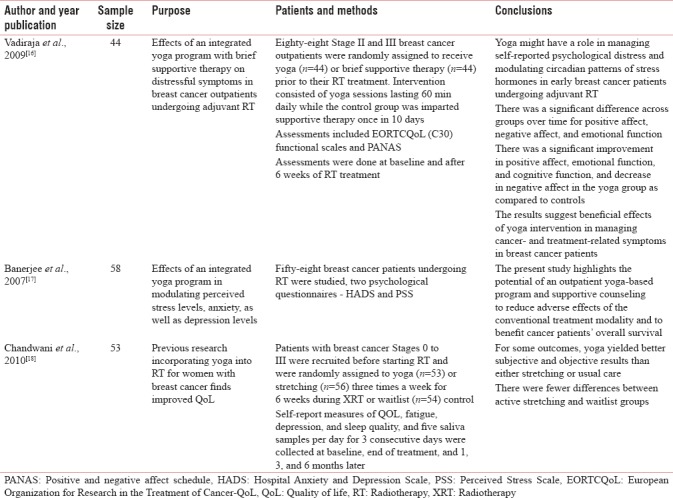Abstract
Purpose:
Several trials on noncancer population indicate that yoga is associated with meaningful clinical effects. This study evaluated the physical and psychosocial outcomes of yoga in oncologic patients treated with radiotherapy.
Methods:
We focused on a research through Cochrane Register of Controlled Trials (CENTRAL), BioMed Central, and MEDLINE studies up to May 2017.
Results:
Yoga was found to have a substantial benefit in cancer patients’ distress, anxiety, and depression. It also demonstrated a moderate impact on fatigue and emotional function and a small and insignificant effect on functional well-being and sleep disturbances. As far as the effects on psychological outcomes are concerned, there was insufficient evidence.
Conclusions:
This systematic review of randomized controlled trials showed that yoga has strong beneficial effects on oncologic patients’ quality of life. Results of the current review must be interpreted with caution due to the relative small sample sizes of most of the included studies, while a prospective randomized study stands in need for the confirmation of our results.
Keywords: Radiotherapy, review, yoga
INTRODUCTION
The role of radiation therapy (RT) is particularly important for the treatment of many malignancies, since ~60% of cancer patients receive RT as a part of their therapeutic regimen.[1] The RT success depends on the type of cancer, the anatomic affected site, the tumor staging, and the presence of comorbidities. The RT acute and late side effects are of concern, as they can significantly influence the quality of life (QoL).[2] The most common symptoms experienced by patients are mainly pain, anxiety, depression, sleep disturbance, nausea, vomiting, diarrhea, and decreased appetite. The sequelae may continue for a long period even after the RT has ended.[3] Many treated patients decide to use complementary and alternative medicine techniques as an attempt to alleviate their disturbances.[4,5]
Yoga is considered as a “mind–body” exercise due to the combination of physical action with breathing and meditation.[6] It is recognized as the sixth most commonly used alternative health practice among the U.S. adults and it stands as a complement to standard medical care treatment.[7] Although no scientific evidence exists, yoga can help protect and support patients’ physical, mental, and spiritual strength.[8] Nowadays, yoga appears to be very popular among cancer patients[9] because it is thought to help manage cancer-related symptoms.[9] Several studies in the noncancer population reported positive effects of yoga on physical and psychological outcomes.[10,11,12,13,14,15]
The aim of the present study is to conduct a systematic review of the effects of yoga in cancer patients and survivors who underwent RT, focusing particularly on both physical and psychosocial benefits.
METHODS
The key words used for the search were: “Yoga”, “Radiotherapy”, “Randomized Controlled Trial,” and synonyms. A literature review was performed based on database search in Cochrane Register of Controlled Trials (CENTRAL), BioMed Central, and MEDLINE up to May 2017.
Study inclusion criteria were as follows: (a) design: randomized controlled trial (RCT), (b) population: adults >18 years old, with any cancer diagnosis either during or posttreatment, (c) intervention: yoga, (d) control group: nonexercise, (e) outcome: physical and psychosocial results, and (f) text language: English.
The search of the literature identified thirty-six (36) papers. Thirty-three (33) publications were excluded after the study of their summaries, as they were not related to “Benefits of yoga in cancer patients and survivors: A systematic review of randomized controlled trials [Figure 1].”
Figure 1.

Literature search results and study selection.
The quality rating of included studies was based on the Cochrane Risk of Bias Tool. The quality of the studies was high [Figure 2].
Figure 2.

Risk of bias summary (Cochrane collaboration).
RESULTS
From a review of all published studies up to February 2017, a total of 155 oncologic patients (sample sizes ranged from 44 to 58), treated with RT, were evaluated. They were randomly assigned to receive yoga or brief supportive therapy prior to RT treatment [Table 1].
Table 1.
Characteristics of selected studies

This systematic review described and evaluated three papers examining yoga as a practice to improve psychosocial symptoms in oncologic RT patients. The study included only RCT focusing on yoga interventions with physical postures and evaluating the effectiveness on psychosocial outcomes.
Through our research, yoga was found to be a feasible modality in oncologic patients treated with RT. Beneficial effects on several physical and psychosocial symptoms and a small impact on functional well-being were reported.
Vadiraja et al.[16] compared the results of a 6-week integrated yoga program with the effects of a brief supportive therapy as a control intervention in early operable breast cancer patients undergoing adjuvant RT. The mean age of participants was 46 years in yoga arm group (Ny) and 48.45 years in control arm group (Nc) (Ny = 44, Nc = 44). Paired sample t-test done to assess within-group change showed a statistically significant decrease in self-report anxiety scores in the Ny (t = 7.24, P < 0.001) and Nc (t = 2.15, P = 0.04) following intervention. Analysis of covariance on postintervention measures using baseline anxiety as a covariate showed a significant decrease in self-report anxiety in the yoga group compared with controls (F (1, 73) = 15.4, P < 0.001]). Paired sample t-test done to assess within-group change showed a significant decrease in self-report depression within the Ny (t = 6.26, P <.001) and Nc (t=3.23, P = 0.01). Analysis of covariance on postintervention measures using baseline depression scores as a covariate showed a significant decrease in self-report depression in the Ny compared with Nc (F[1, 73] = 10.7, P = 0.002). Paired sample t-test done to assess within-group change showed a significant decrease in perceived stress in the Ny (t=5.5, P < 0.001) but not in the Nc (t=1.42, P = 0.17). Analysis of covariance on postintervention measures using baseline perceived stress score as a covariate showed a significant decrease in perceived stress in the Ny compared with Nc (F[1, 72] = 18.05, P < 0.001). The authors concluded that yoga might have a role in managing self-reported psychological distress and modulating circadian patterns of stress hormones in early breast cancer patients undergoing adjuvant RT.
Banerjee et al.[17] studied the effect of an intensive yoga program on psychological parameters (Hospital Anxiety and Depression Scale and Perceived Stress Scale [PSS]) as well as RT-induced DNA damage in the peripheral blood lymphocytes derived from the breast cancer patients pre- and post-RT, using both an intervention and a supportive counseling group. A total of 58 patients completed the study. The mean age of all participants was 44 years. There was a significant decrease in the anxiety levels in the Ny intervention group from a mean of 8.5 (standard deviation [SD] =1.6) at baseline to a mean of 4.1 (SD = 1.0) (48.2%) after the 6-week yoga program. In the Nc group, the mean anxiety score increased from 8.2 (SD = 1.1) to 10.5 (SD = 1.8) (28%). Based on repeated ANCOVA measures, controlling for baseline values of each dependent variable, the change in anxiety was significantly different between the groups (P < 0.001). The post-RT depression score for the intervention group decreased from a mean of 8.0 (SD = 1.9) at baseline to a mean of 3.4 (SD = 0.5) (57.5%) after the yoga program. In the Nc group, the score increased from 7.8 (SD = 0.9) at baseline to 9.7 (SD = 1.2) (24%). Based on repeated ANCOVA measures, controlling for baseline values of each dependent variable, the change in depression was significantly different between the groups (P < 0.001). In the Ny, the mean PSS decreased from 20.4 (SD = 2.8) at baseline to 14.9 (SD = 2.4) post-RT (26.9%), whereas the Nc showed no change pre- and post-RT ([mean = 19.0, SD = 2.1] at baseline and [mean = 20.4, SD = 2.5] post-RT). The authors concluded that yoga intervention modulates the stress levels in breast cancer patients during RT.
Chandwani et al.[18] evaluated the hypothesis that participation in yoga three times a week during RT would have long-term effects on physical and mental health aspects of QoL (primary end points), fatigue, depression, and sleep (secondary end points) relative to an active stretching or waitlist control groups (Ny = 53, Nstretching = 56, Nwaitlist = 54). The mean age of all participants was 51.9 years. The authors concluded that, for some outcomes, yoga yielded better subjective and objective results than either stretching or usual care. There were fewer differences between active stretching and waitlist groups.
DISCUSSION
The present study demonstrated that yoga has large beneficial effects on distress, anxiety, and depression; moderate beneficial effects on emotional function; and a small effect on sleep disturbance. Psychosocial effects, cognitive function, vigor, anger, hostility, spirituality, relaxation, and mental health were also studied, therefore the evidences of yoga's effects on them are insufficient.
Future prospective RCTs stand in need, to evaluate the effects of yoga on (a) physical status, (b) psychosocial situation, (c) the optimal frequency, (d) duration of yoga, (e) in types of cancer different from breast cancer, and (f) the optimal time point in the cancer and cancer treatment or rehabilitation trajectories for offering yoga interventions.
CONCLUSION
The present study has some limitations. We included articles published only in the English language and we may have missed important findings from yoga in Asia, in which yoga practicing is much more common than in Western countries. However, in this retrospective study, we included two trials that were conducted in Asia. We should note that evidence of physical effects of yoga was generally insufficient to draw firm conclusions, because of the limited number of studies per physical result. Nevertheless, the small effect of yoga on physical function and functional well-being maybe related to the short intervention duration. To improve physical function and fitness, longer duration of intervention may be required.
This systematic review of RCTs showed that yoga has an important beneficial effect on cancer patients’ distress, anxiety, and depression; a moderate effect on fatigue and emotional function; and an insignificant effect on functional well-being and sleep disturbances. Regarding the effects on psychological outcomes, there was insufficient evidence. Results of the current review must be interpreted with caution due to the relatively small sample sizes of most of the included studies.
Financial support and sponsorship
Nil.
Conflicts of interest
There are no conflicts of interest.
REFERENCES
- 1.Moding EJ, Kastan MB, Kirsch DG. Strategies for optimizing the response of cancer and normal tissues to radiation. Nat Rev Drug Discov. 2013;12:526–42. doi: 10.1038/nrd4003. [DOI] [PMC free article] [PubMed] [Google Scholar]
- 2.Berkey FJ. Managing the adverse effects of radiation therapy. Am Fam Physician. 2010;82:381–8. 394. [PubMed] [Google Scholar]
- 3.Patrick DL, Ferketich SL, Frame PS, Harris JJ, Hendricks CB, Levin B, et al. National institutes of health state-of-the-science conference statement: Symptom management in cancer: Pain, depression, and fatigue, July 15-17, 2002. J Natl Cancer Inst. 2003;95:1110–7. doi: 10.1093/jnci/djg014. [DOI] [PubMed] [Google Scholar]
- 4.Molassiotis A, Fernadez-Ortega P, Pud D, Ozden G, Scott JA, Panteli V, et al. Use of complementary and alternative medicine in cancer patients: A European survey. Ann Oncol. 2005;16:655–63. doi: 10.1093/annonc/mdi110. [DOI] [PubMed] [Google Scholar]
- 5.Bernstein BJ, Grasso T. Prevalence of complementary and alternative medicine use in cancer patients. Oncology (Williston Park) 2001;15:1267–72. [PubMed] [Google Scholar]
- 6.Lipton L. Using yoga to treat disease: An evidence-based review. JAAPA. 2008;21:34–6. doi: 10.1097/01720610-200802000-00012. 38, 41. [DOI] [PubMed] [Google Scholar]
- 7.National Center for Complementary and Alternative Medicine. Yoga for Health. 2013. [Last accessed on 2017 Nov 04]. Available from: http://www.nccam.nih.gov/health/yoga/introduction.htm .
- 8.Culos-Reed SN, Carlson LE, Daroux LM, Hately-Aldous S. Discovering the physical and psychological benefits of yoga for cancer survivors. Int J Yoga Ther. 2004;14:45–53. [Google Scholar]
- 9.Cramer H, Lange S, Klose P, Paul A, Dobos G. Yoga for breast cancer patients and survivors: A systematic review and meta-analysis. BMC Cancer. 2012;12:412. doi: 10.1186/1471-2407-12-412. [DOI] [PMC free article] [PubMed] [Google Scholar]
- 10.Telles S, Ramaprabhu V, Reddy SK. Effect of yoga training on maze learning. Indian J Physiol Pharmacol. 2000;44:197–201. [PubMed] [Google Scholar]
- 11.Raub JA. Psychophysiologic effects of hatha yoga on musculoskeletal and cardiopulmonary function: A literature review. J Altern Complement Med. 2002;8:797–812. doi: 10.1089/10755530260511810. [DOI] [PubMed] [Google Scholar]
- 12.Tran MD, Holly RG, Lashbrook J, Amsterdam EA. Effects of hatha yoga practice on the health-related aspects of physical fitness. Prev Cardiol. 2001;4:165–70. doi: 10.1111/j.1520-037x.2001.00542.x. [DOI] [PubMed] [Google Scholar]
- 13.Blank SE, Kittel J, Haberman MR. Active practice of Iyengar yoga as an intervention for breast cancer survivors. Int J Yoga Ther. 2010;15:51–9. [Google Scholar]
- 14.Carson JW, Carson KM, Porter LS, Keefe FJ, Seewaldt VL. Yoga of awareness program for menopausal symptoms in breast cancer survivors: Results from a randomized trial. Support Care Cancer. 2009;17:1301–9. doi: 10.1007/s00520-009-0587-5. [DOI] [PubMed] [Google Scholar]
- 15.Galantino M, Cannon N, Hoelker T, Iannaco J, Quinn L. Potential benefits of walking and yoga on perceived level of cognitive decline and persistent fatigue in women with breast cancer. Rehabil Oncol. 2007;25:3–16. [Google Scholar]
- 16.Vadiraja HS, Raghavendra RM, Nagarathna R, Nagendra HR, Rekha M, Vanitha N, et al. Effects of a yoga program on cortisol rhythm and mood states in early breast cancer patients undergoing adjuvant radiotherapy: A randomized controlled trial. Integr Cancer Ther. 2009;8:37–46. doi: 10.1177/1534735409331456. [DOI] [PubMed] [Google Scholar]
- 17.Banerjee B, Vadiraj HS, Ram A, Rao R, Jayapal M, Gopinath KS, et al. Effects of an integrated yoga program in modulating psychological stress and radiation-induced genotoxic stress in breast cancer patients undergoing radiotherapy. Integr Cancer Ther. 2007;6:242–50. doi: 10.1177/1534735407306214. [DOI] [PubMed] [Google Scholar]
- 18.Chandwani KD, Thornton B, Perkins GH, Arun B, Raghuram NV, Nagendra HR, et al. Yoga improves quality of life and benefit finding in women undergoing radiotherapy for breast cancer. J Soc Integr Oncol. 2010;8:43–55. [PubMed] [Google Scholar]


